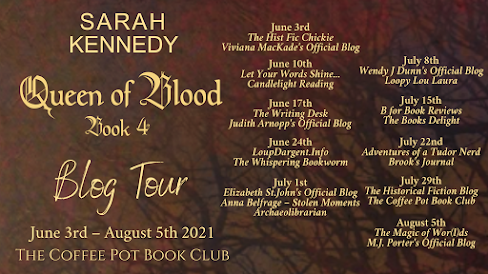Queen of Blood, Book Four of the Cross and the Crown series,
continues the story of Catherine Havens, a former nun in Tudor England. It is
now 1553, and Mary Tudor has just been crowned queen of England. Still a Roman
Catholic, Mary seeks to return England to its former religion, and Catherine
hopes that the country will be at peace under the daughter of Henry VIII. But
rebellion is brewing around Thomas Wyatt, the son of a Tudor courtier, and when
Catherine’s estranged son suddenly returns from Wittenberg amid circulating
rumours about overthrowing the new monarch, Catherine finds herself having to
choose between the queen she has always loved and the son who seems determined
to join the Protestants who seek to usurp her throne.
Fun Facts
Sarah Kennedy
(Stuff you
may or may not already know!)
I talk to owls. I love
nature, and I spend a lot of time out of doors. I particularly enjoy listening
to and identifying local birds, especially the owls who call to each other at
dusk. Many screech owls live near my house, and from my deck, I can hear their
conversations. Screech owls don’t actually “screech” at all. They whinny. So,
of course, I practiced imitating them. One evening, I was clearing out brush
near the edge of the little woods that surrounds my house, and there, on a
nearby branch, sat a screech owl. They are tiny, and I almost didn’t see it,
but there it was, staring at me. I whinnied at it, and it put its head on one
side, as though trying to determine what such a big and ugly owl was doing
speaking to it, but finally it came to me. It was almost within hand’s reach!
But I didn’t touch it, for fear of scaring it. We sat and spoke to each other
for a minute or two, and then it flew away, probably to spread the word that a
giant owl was in the neighborhood. It was a truly magical moment, one that I
hope at some time to repeat.
I used to be a pianist, and I thought, when I was a young woman, that I would devote my life and my career to playing the piano. I studied quite seriously, but I found, once I began college, that my daily practice times were being interrupted constantly by my own thoughts—about words. Images, metaphors, and sentences kept me from focusing on the notes, and I finally gave up my music for English studies and became a poet. Now I write fiction, but even decades later I still almost hear my own sentences as melodies, though not ones that I would sing for anyone else! Music and language still intersect in my imagination, and I suppose they always will.
I once weeded a thirty-acre field of corn, by myself, by hand. I did this in small daily increments with a hand-held hoe. I was very young and full of ideas about physical work and spiritual improvement. It certainly was good exercise, and I did a lot of thinking while I worked, but I don’t ever want to do that again! The field was nice and clean, for a while, but I believe I was quite foolish when I was young.
I’m left-handed, from a generation of lefties. I am the youngest of a family of six, and four of us are left-handed. Happily, our parents did not try to force us to be right-handed, and my mother made sure that we had left-handed scissors every fall for school projects (though she had fits trying to teach any of us to sew). Neither of our parents was left-handed, nor were our grandparents. None of our children, or grandchildren so far, is left-handed. For some reason, it seems to have hit my generation in our family and no other.
I love the semicolon. Why? I suppose I just love punctuation! Many writers ridicule, revile, insult, ignore, and abuse the semicolon, but it’s one of my favorites. It’s like a wink to the reader; it says, “there’s more coming up.” It keeps things together, yet it holds them gently apart. My students might sigh and roll their eyes, but I tell them that they need to know how to use one correctly. The semicolon is rather shy; it’s not aggressive, like the exclamation point, or unsure of itself, like the question mark. It’s not demanding, like the slammed-down fist of the period. The semicolon knows its place; it holds others in theirs.
¸.•*´¨)✯ ¸.•*¨) ✮ ( ¸.•´✶
Sarah Kennedy
Sarah Kennedy is the author of the Tudor historical series, The Cross and the Crown, including The Altarpiece, City of Ladies, The King’s Sisters, and Queen of Blood. She has also published a stand-alone contemporary novel, Self-Portrait, with Ghost, as well as seven books of poems. A professor of English at Mary Baldwin University in Staunton, Virginia, Sarah Kennedy holds a PhD in Renaissance Literature and an MFA in Creative Writing. She has received grants from both the National Endowment for the Arts, the National Endowment for the Humanities, and the Virginia Commission for the Arts.
Connect with Sarah




I love your Fun Facts posts!!
ReplyDeleteThank you so much for hosting today's tour stop.
My pleasure.
ReplyDelete